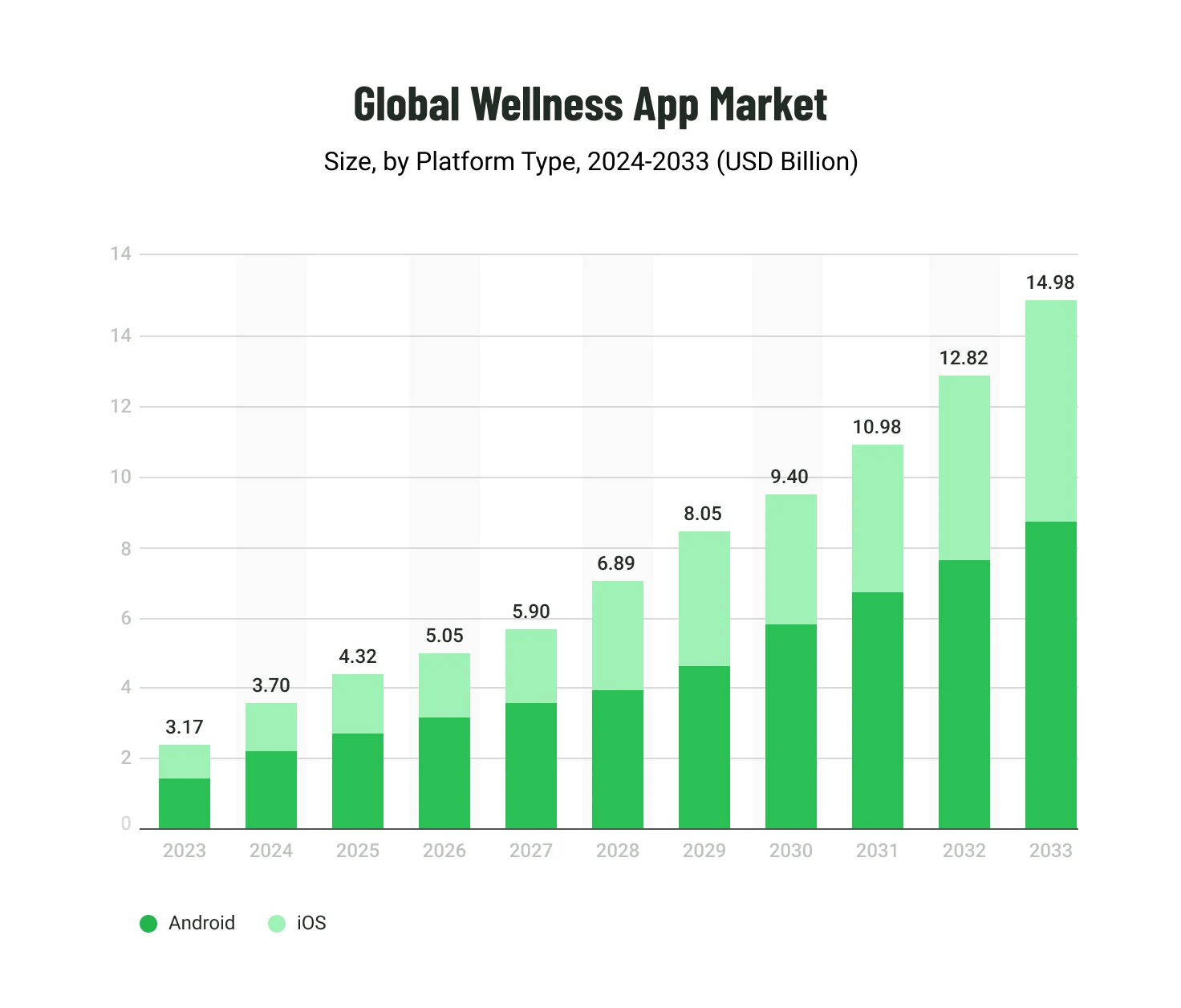The Rise of Health and Wellness Apps in 2025
In 2025, health and wellness apps have solidified their position as essential components in the landscape of personal well-being. This remarkable growth trajectory is marked by cutting-edge technological innovation and deeper user engagement, reshaping how individuals approach health, fitness, and mental wellness. The digital health revolution is just beginning, with apps playing a central role in promoting a proactive approach to well-being.
The Evolution of Digital Health
The rise of health and wellness apps in 2025 marks a pivotal shift in how individuals engage with their well-being, blending cutting-edge technology with everyday lifestyle choices. No longer confined to basic fitness tracking, these apps now offer holistic, data-driven solutions that cater to mental health, nutrition, sleep optimization, and chronic disease management. Powered by AI and machine learning, they analyze user behavior in real time, delivering personalized recommendations that adapt dynamically to changing needs.
One of the most transformative aspects of these apps is their ability to bridge gaps in traditional healthcare. For instance, mental wellness platforms leverage cognitive behavioral therapy (CBT) techniques through chatbots, while nutrition apps sync with smart kitchen devices to suggest meals based on biometric data. Wearables have evolved beyond step counting, now monitoring stress levels, blood oxygen saturation, and even early signs of metabolic disorders—feeding this data back into apps for actionable insights.
Another critical driver is the gamification of wellness, where behavioral psychology meets digital engagement. Apps reward users for consistency, turning healthy habits into addictive challenges. Social connectivity features further amplify this, allowing communities to share progress, compete, and offer peer support. Meanwhile, corporate wellness programs increasingly integrate these apps, recognizing their role in reducing healthcare costs and boosting productivity.
Privacy and ethical considerations remain central, as the collection of sensitive health data demands robust encryption and transparent policies. Yet, as interoperability between devices and electronic health records improves, the potential for seamless, preventive care grows exponentially. This digital revolution isn’t just changing how we track health—it’s redefining how we live it.
Decoding the Surge in Market Growth
The wellness app market is experiencing unprecedented growth, projected to surpass USD 26 billion by 2030, driven by a convergence of economic, technological, and societal factors. This expansion is fueled by a compound annual growth rate (CAGR) of over 17%, reflecting the increasing reliance on digital solutions for health management. The surge is not just a trend but a fundamental shift in how individuals engage with their well-being, spurred by rising healthcare costs, greater health awareness, and the ubiquity of smartphones.
Key economic drivers include:
- Cost efficiency – Wellness apps offer affordable alternatives to traditional healthcare, reducing expenses for both users and providers.
- Corporate wellness programs – Employers are integrating apps into benefits packages to improve workforce productivity and reduce absenteeism.
- Global accessibility – Digital platforms bridge gaps in healthcare access, particularly in underserved regions, democratizing wellness.
Revenue trends highlight a shift toward subscription-based models, with users willing to pay for premium features like AI-driven insights, which we will explore in the next chapter. Additionally, the integration of wearables—discussed later—has amplified demand by enabling real-time health tracking.
The market’s expansion is also propelled by generational preferences, with Millennials and Gen Z prioritizing convenience and personalization. As digital health evolves from reactive care to proactive wellness—building on the foundations laid by electronic records and telemedicine—apps are becoming indispensable tools in daily life. This growth trajectory underscores a broader transformation, where digital well-being is no longer optional but integral to modern living.
AI-Driven Personalization & Integration
The integration of artificial intelligence (AI) and wearable technology has redefined personal well-being in 2025, transforming health and wellness apps from passive trackers into proactive, hyper-personalized companions. Unlike the market-driven growth discussed earlier, this chapter focuses on the technological breakthroughs enabling these apps to deliver precision-based recommendations. AI algorithms now analyze real-time biometric data—heart rate variability, sleep cycles, and even stress levels—to generate dynamic health insights tailored to individual needs.
Wearables have evolved beyond step counting, embedding advanced sensors that monitor everything from blood oxygen saturation to cortisol levels. When synced with AI-powered apps, this data fuels adaptive wellness plans. For instance, an app might adjust a user’s hydration reminders based on sweat loss detected by their smartwatch during a workout or recommend meditation if stress biomarkers spike. Machine learning further refines these suggestions by learning from user behavior, ensuring recommendations grow more accurate over time.
Seamless integration across devices is another game-changer. Health ecosystems now unify wearables, smartphones, and even smart home devices, creating a holistic view of well-being. A sleep-tracking app might sync with a smart thermostat to optimize bedroom temperature, while a nutrition app could pull data from a glucose monitor to suggest meal plans. This interoperability eliminates friction, making health management effortless.
As we transition to the next chapter on gamification, it’s clear that AI and wearables lay the foundation for engagement by making health intuitive and responsive. The next frontier? Leveraging these personalized insights to craft immersive, game-like experiences that keep users motivated.
Gamification: The New Engagement Model
Building on the AI-driven personalization discussed earlier, gamification has emerged as a powerful tool to keep users engaged in their wellness journeys. By transforming mundane health routines into interactive challenges, apps in 2025 are leveraging game mechanics to foster long-term commitment. Points, badges, leaderboards, and progress tracking are no longer just gaming staples—they’re now integral to motivating users to hit their fitness goals, meditate daily, or maintain balanced nutrition.
One of the most effective techniques is behavioral nudging, where apps use real-time rewards to reinforce positive habits. For example, completing a week of workouts might unlock a virtual achievement or even tangible discounts from wellness partners. Social features, like competing with friends or joining community challenges, add a layer of accountability that AI alone can’t replicate. Studies show that users who engage with gamified elements are 30% more likely to stick with their routines compared to those using traditional tracking apps.
Beyond fitness, mental health apps are also adopting gamification to make mindfulness practices more accessible. Guided meditation apps now incorporate streak counters and visual progress trees, turning relaxation into a rewarding experience. Even sleep-tracking apps use gentle competitions to encourage better bedtime habits. The key lies in balancing fun with functionality—ensuring that gamification enhances, rather than distracts from, the core wellness objectives.
As we move toward the all-in-one wellness platforms discussed in the next chapter, gamification serves as the glue that binds diverse features together. By making health engaging, apps aren’t just tracking progress—they’re inspiring lasting behavioral change.
The All-in-One Approach to Wellness
The rise of health and wellness apps in 2025 has ushered in a new era of holistic digital well-being, where users no longer need to juggle multiple platforms for different aspects of their health. Instead, modern apps are adopting an all-in-one approach, seamlessly integrating nutrition tracking, fitness routines, mental health support, and habit formation into a single, intuitive interface. This shift reflects a growing demand for comprehensive solutions that address well-being as an interconnected system rather than isolated components.
One of the key drivers behind this trend is the recognition that physical health, mental resilience, and lifestyle habits are deeply intertwined. Apps now leverage AI-driven personalization to analyze user data across these domains, offering tailored recommendations that adapt in real time. For instance, a user logging poor sleep might receive not just sleep hygiene tips but also adjusted workout intensity and mindfulness exercises to mitigate fatigue. This level of integration was rare in earlier apps, which often specialized in just one area, forcing users to manually correlate insights.
Another breakthrough is the unified dashboard, where metrics from fitness, nutrition, and mental health are visualized together, helping users identify patterns and correlations. A spike in stress levels, for example, might be linked to skipped meals or excessive caffeine intake—insights that would have been harder to spot with fragmented apps.
The move toward holistic platforms also aligns with the broader digital wellness ecosystem, where gamification (as discussed earlier) enhances engagement, and corporate wellness programs (to be explored next) integrate these tools for workforce health. By breaking down silos, these apps are not just simplifying wellness—they’re redefining it.
Pioneering the Future of Corporate Wellness
The corporate landscape in 2025 has undergone a seismic shift in how employee well-being is prioritized, thanks to the integration of health and wellness apps into workplace strategies. Companies are no longer relying solely on traditional wellness programs; instead, they are leveraging digital solutions to foster healthier, more engaged workforces. These apps are not just perks—they are now central to corporate health policies, driving measurable improvements in productivity, job satisfaction, and long-term employee retention.
One of the most significant changes is the personalization of wellness programs. Advanced AI-driven apps analyze employee data—such as activity levels, sleep patterns, and stress markers—to deliver tailored recommendations. For instance, a sedentary employee might receive prompts for micro-workouts, while another struggling with burnout could access guided meditation sessions. This level of customization ensures that wellness initiatives are not one-size-fits-all but adapt to individual needs, maximizing their effectiveness.
Moreover, gamification has become a cornerstone of corporate wellness apps. Leaderboards, challenges, and rewards transform health goals into engaging, social experiences. Teams compete in step challenges or mindfulness streaks, fostering camaraderie while improving health metrics. Employers report that these features not only boost participation but also create a culture where well-being is a shared priority.
The impact extends beyond physical health. Mental health apps integrated into corporate platforms offer on-demand therapy, stress management tools, and even AI-powered chatbots for immediate support. Companies are seeing reduced absenteeism and higher morale as employees feel genuinely supported in their holistic well-being.
As the line between work and wellness blurs, corporations that embrace these digital innovations are setting new standards for a healthier, more resilient workforce. The future of corporate wellness is not just about policies—it’s about empowering employees through technology.
Key Players and Popular Segments
The health and wellness app market in 2025 is thriving, driven by consumer demand for personalized, accessible, and data-driven solutions. Among the most dominant segments are exercise & weight loss and mental health, each catering to distinct yet interconnected aspects of well-being. Leading apps like FitGenius and MindEase exemplify how digital platforms are evolving to meet user expectations with AI-powered customization, real-time feedback, and seamless integration into daily routines.
In the exercise & weight loss category, apps now leverage advanced biometric tracking, combining wearable data with machine learning to deliver hyper-personalized workout and nutrition plans. FitGenius, for instance, adapts routines based on sleep patterns, stress levels, and even genetic predispositions, making fitness more intuitive than ever. Meanwhile, NutriSync uses augmented reality to scan meals and provide instant nutritional insights, bridging the gap between convenience and health consciousness.
The mental health segment has seen exponential growth, with apps like MindEase offering on-demand therapy, mood tracking, and AI-driven cognitive behavioral therapy (CBT) modules. These platforms prioritize accessibility, breaking down barriers to mental health care with affordable subscriptions and 24/7 support. Another standout, ZenFlow, integrates mindfulness exercises with biofeedback from smartwatches, helping users manage stress in real time.
What sets these apps apart is their ability to align with broader lifestyle trends—such as holistic health and preventive care—while maintaining user engagement through gamification and community features. As corporate wellness programs increasingly adopt these tools (as discussed in the previous chapter), their influence extends beyond individual users, shaping a culture where digital well-being is inseparable from daily life. This sets the stage for deeper industry collaboration, a theme explored in the next chapter, where partnerships between tech innovators and healthcare providers will further redefine wellness in the digital age.
Industry Collaboration and Innovation
The health and wellness app ecosystem in 2025 thrives on collaboration, with tech giants, healthcare institutions, and governments working together to push the boundaries of digital well-being. Unlike the siloed approaches of the past, today’s innovations emerge from cross-industry partnerships that blend expertise, resources, and data to create more holistic solutions. For example, wearable tech companies like Apple and Fitbit now integrate directly with hospital EHR systems, allowing doctors to monitor patient vitals in real time and adjust treatment plans proactively. This synergy between consumer tech and clinical care bridges gaps in preventive health, reducing hospital readmissions by nearly 20% in pilot programs.
Government initiatives have also accelerated adoption. In the EU, public-private partnerships like Digital Health Europe fund AI-driven mental health apps, making them accessible through national healthcare portals. Meanwhile, startups collaborate with insurers to offer subscription-based wellness programs that lower premiums for users who meet fitness goals—a model that’s grown 300% since 2023. These alliances don’t just expand reach; they validate apps as credible tools, overcoming skepticism that once limited their use to niche audiences.
Pharma companies are joining the fray, too. Pfizer’s partnership with Headspace to deliver stress-management modules for chronic illness patients exemplifies how therapeutic content is being personalized at scale. Such innovations rely on shared data pools—anonymized and secure—to tailor recommendations, a leap forward from the one-size-fits-all apps of earlier years. As these collaborations mature, they’re not just enhancing features but redefining what wellness apps can achieve: no longer standalone trackers, but integrated nodes in a global health network.
Navigating Revenue and Usage Trends
The wellness app industry is experiencing unprecedented financial growth, with in-app purchases projected to double by 2030. This surge is fueled by a combination of consumer demand and corporate adoption, transforming these digital tools into essential components of modern health management. Users are no longer just passive consumers—many now view wellness apps as long-term investments in their well-being, driving sustained revenue through subscriptions, premium features, and personalized add-ons.
Corporate wellness programs have become a major catalyst for market expansion. Employers are increasingly integrating wellness apps into employee benefits, recognizing their potential to reduce healthcare costs and boost productivity. Nearly 60% of mid-sized companies now offer subsidized access to mental health, fitness, or nutrition apps, creating a steady revenue stream for developers. Meanwhile, insurers and healthcare providers are partnering with app creators to offer data-driven wellness incentives, further embedding these tools into the healthcare ecosystem.
Usage trends reveal a shift toward hyper-personalization. AI-driven recommendations, real-time biometric feedback, and adaptive coaching algorithms are no longer luxury features—they’re expected standards. Users are willing to pay for apps that evolve with their needs, leading to higher retention rates and increased lifetime value. Additionally, the rise of wearable tech integration has blurred the lines between passive tracking and active health management, making wellness apps indispensable for users seeking holistic well-being.
As revenue models mature, freemium strategies dominate, but with a twist: free tiers now serve as sophisticated onboarding funnels rather than limited trials. The most successful apps leverage behavioral science to nudge users toward premium tiers, ensuring monetization doesn’t compromise engagement. With corporate adoption and consumer loyalty converging, wellness apps are no longer niche—they’re a cornerstone of digital health in 2025.
Looking Ahead: The Future of Wellness Apps
The future of health and wellness apps in 2025 and beyond is poised to be shaped by a convergence of cutting-edge technologies and evolving user demands. As the market matures beyond revenue and adoption trends, the next wave of innovation will focus on hyper-personalization, predictive analytics, and seamless integration with broader healthcare ecosystems.
One of the most transformative developments will be the rise of AI-driven wellness companions. Unlike today’s reactive apps, these next-gen solutions will leverage real-time biometric data, behavioral patterns, and even genetic insights to offer proactive recommendations. Imagine an app that not only tracks your sleep but predicts stress-induced insomnia and adjusts your daily routine before it happens.
Wearables will evolve beyond step counters, becoming non-invasive health monitors capable of detecting early signs of chronic conditions like diabetes or hypertension through advanced sensors. These devices will sync with wellness apps to provide users and healthcare providers with actionable insights, bridging the gap between prevention and treatment.
Another key trend will be the gamification of mental health. With rising awareness around emotional well-being, apps will incorporate immersive experiences like VR meditation or AI-powered therapy bots that adapt to users’ emotional states in real time.
Finally, interoperability will be critical. Future wellness apps won’t exist in silos but will integrate with electronic health records (EHRs), telehealth platforms, and even workplace wellness programs, creating a unified digital well-being ecosystem. As privacy concerns grow, decentralized technologies like blockchain may also play a role in securing sensitive health data while enabling seamless sharing across trusted networks.
The next era of wellness tech won’t just track health—it will anticipate, personalize, and revolutionize how we define well-being.

Conclusions
As we peer into the future of health and wellness in 2025, it’s clear that these apps are more than just trends; they are paradigm-shifting tools that are redefining the essence of personal health care. By blending AI-driven personalization, comprehensive functionalities, and global accessibility, they pave the way for a future where managing health is intuitive, engaging, and deeply integrated into our daily lives.



